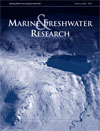Marine and Freshwater Research
Volume 63
Number 6 2012
Information of the age composition, reproductive characteristics and growth rates of animal populations is vital for implementation of effective management and conservation plans, as well as understanding trophic interactions. We aimed to quantify these parameters for the brown stingray, Dasyatis lata, an abundant benthic predator in Hawai’i, and found that they are long-lived, slow growing and mature at a late age. Our study highlights the importance of obtaining baseline data for elasmobranchs before fisheries are established.
Understanding the dynamics of salt intrusion in a coastal karst aquifer is fundamental to assessing the impacts of land use and climatic change on these systems. We collected field data from a Mexican karst system to show that sea-level variability at low frequencies may induce salt penetration further inland. Our findings indicated that sea-level rise and the alteration of rain patterns threaten water availability.
The effect of a river regulation gradient on longitudinal trends in rivers has rarely been investigated. This study suggests that an increase in river regulation leads to greater disruption of longitudinal patterns, with the greatest impacts shown on macroinvertebrate assemblages. Such effects should be considered when planning and managing dams so as to reduce their effect on these ecosystems.
The leafscale gulper is a globally distributed deepwater shark threatened by commercial fisheries in parts of its range. We used molecular genetic markers to investigate its poorly understood stock structure in the eastern Atlantic and southwestern Pacific oceans, and found evidence of a single genetic stock. Our results indicate there is little risk of genetic diversity loss in the event of a local depletion, but high local fishing mortality may have far reaching impacts due to the unequal distribution of sizes and sexes along the stock’s geographic range.
Changes in ice cover on five Australian lakes have a profound effect on lake chemistry, particularly with ice break-up occurring significantly earlier. pH fell beneath winter ice whereas NOx-N and NH3-N peaked at orders of magnitude greater than in summer, despite atmospheric sources being an order of magnitude lower. These lakes reflect changes in climate through ice duration and changes in chemistry.
Offshore wind stress data is necessary for many different applications; however, in the coastal ocean around Australia, it is seldom available. A proxy wind stress data source in the Sydney region was found by comparing offshore wind data (that is no longer collected) with data from over-land meteorological stations and re-analysis products. The results show that careful site selection is required and the implications for oceanographic modelling in the coastal area are discussed.
Batesian mimicry occurs when a harmless species mimics an unpalatable or dangerous model species resulting in reduced chances of predation and, therefore, increased survival. We address the six criteria of Batesian mimicry using evidence from the literature to propose that juvenile zebra sharks (Stegostoma fasciatum) mimic banded sea snakes in colouration, body form and swimming motion. This is the first proposal for mimicry in an elasmobranch species and raises interesting questions about how far widespread mimicry may occur.
The western blue groper (Achoerodus gouldii) is a large, long-lived fish that is intrinsically vulnerable to overfishing and other localised impacts. A 12-month acoustic tracking study aimed at determining the movements of adult A. gouldii confirmed that individuals are highly amenable to protection within adequately sized and appropriately located no-take marine protected areas. For one of the largest temperate-reef fishes so far tracked using acoustic technology, A. gouldii has a relatively small home range.




